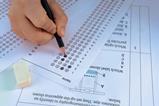Quiz your learners on electrochemistry topics, such as salt bridges, the direction of simple redox reactions and more
This resource accompanies the CPD article Teaching electrochemistry at post-16 in Education in Chemistry, where you will find tips, common misconceptions and further ideas for building student understanding of how electrochemical cells work.
Learning objectives
-
Describe how to set up an electrochemical cell, including:
- The function and use of a salt bridge.
- The relative positions of half cells according to their E ° values.
- The use of a platinum electrode where necessary.
- The components and use of the standard hydrogen electrode.
- Write and apply the conventional representation of an electrochemical cell.
- Use E ° values to predict the direction of simple redox reactions.
- Calculate the EMF (Ecell) and use this value to predict the feasibility of the cell.
How to use this resource
Activity 1 consists of 20 multiple choice questions. Instruct learners to read each question carefully, using the diagrams and data provided to tick an answer. There is one correct answer per question.
After learners mark the multiple choice questions either by peer or self-assessing, they will complete the relevant follow-up tasks to target areas for improvement and increase their understanding of certain topics. If appropriate, guide learners to follow-up tasks based on misconceptions you have already identified throughout the course or for further practice if they get 20/20 on the quiz. Activity 2 is fully differentiated for learners to target their own misconceptions identified from the multiple choice quiz.
There is also an extension task to challenge learners after completing Activities 1 and 2. Find the answers to all of the questions in the teacher notes.
Extension opportunities
Non-rechargeable and rechargeable cells are not explicitly covered in this task. Encourage learners to read the EiC article Batteries and electrochemical cells article as an introduction. As a follow-up activity, use the lead–acid accumulator cell practical to either introduce or revise these concepts.
More resources
- A misconception buster on the topic of atom economy, percentage yield and green chemistry is also available.
- Review your learners’ knowledge of electrochemistry and its applications with these diagnostic questions. They are divided into the key misconceptions and are effective in probing 16–18 year-old learners’ understanding throughout the topic.
- Use the Displacement reaction of silver nitrate and copper metal to establish prior knowledge of redox.
- Watch the Reactivity series of metals and Electrochemical cells practical videos. Plus, download the supporting resources, technician and learner notes.
- Make electrochemistry calculation work more visual with number grids and highlight the different careers chemistry can lead to with our job profiles.
Downloads
Electrochemical cells misconception buster teacher notes
Handout | PDF, Size 0.39 mbElectrochemical cells misconception buster student sheet
Handout | PDF, Size 0.38 mbElectrochemical cells misconception buster teacher notes
Editable handout | Word, Size 0.55 mbElectrochemical cells misconception buster student sheet
Editable handout | Word, Size 0.56 mb
























1 Reader's comment